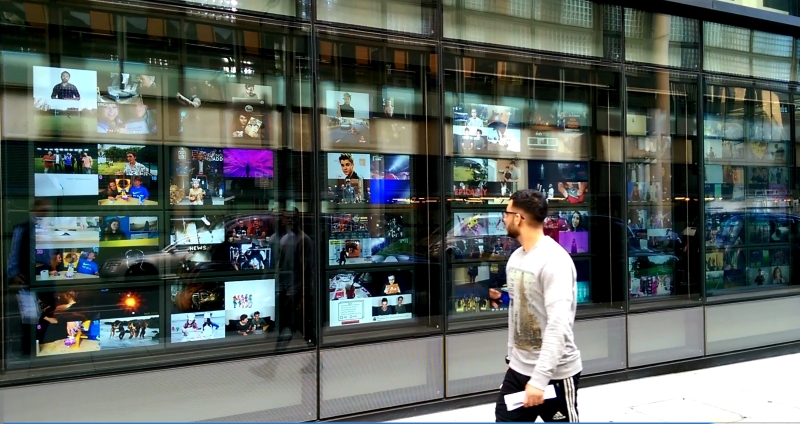More case studies
YouTube Space London
11 January 2018

At the beginning of 2016 we were approached by David Errock of Wave Science Technology to participate in a project to provide digital signage for YouTube in Kings Cross, London; a new facility with three studios for contributors to record YouTube videos and stream live to the internet, as well as provide a space for them to meet and interact.
The primary purpose of the window displays is to attract attention to the building from the street by sharing some of the content available on YouTube.
The project comprised two separate elements that would enable YouTube Space to showcase their new service. The windows facing out to the street have an array of thirty two sunlight readable screens playing a patchwork of various YouTube videos.
Within the building a video wall comprising four 75” screens display a mix of content from their top contributors plus promotional videos describing how YouTubers can benefit from professional advice and how to get the best out of the Kings Cross facilities.
Our Solution
Software
The software is our standard LiveSpace installation together with a custom component to handle the display of YouTube playlists. The individual videos in a playlist are shown simultaneously on panels over the display wall, with the software automatically cueing the next video in the playlist when one finishes playing.
LiveSpace is designed to be easily extensible by providing an API to connect new components without changing the core software. The display software uses a bespoke Webkit based browser and is capable of interfacing with other devices, allowing us to play live video directly from the YouTube studios.
LiveSpace allows the video wall to be broken up in to separate display areas which can be sized and positioned as required. The content for each display area is then handled individually by LiveSpace and can be scheduled to allow changes in the video wall layout to be made at any time.
Hardware
The server manages the system and two client machines drive the displays. The hardware is located in the server room some distance from the displays and fibre-based HDMI extensions from Lightware have been used to connect to the screens. The display hardware uses Datapath video wall servers. Image DP4 cards drive the outputs with Vision SC-SDI4 cards providing live video capture of 4K video split into quadrants. Active SQX cards stream video from the network directly to the screens.
A separate server provides video wall capability to a two over two arrangement of 75” screens mounted on the internal walls where YouTube’s biggest stars congregate.
The window screens, facing out onto the street needed to be sunlight readable. Our solution incorporates 1,500 lumen high brightness screens with a transflective layer mounted in a bespoke housing to fit the available space. The transflective layer reflects sunlight back from the screen, increasing the brightness when in sunlight without requiring extra power. A light sensor has also been incorporated into the housing to adjust the screens brightness so that all screens are less bright at night.
Summary
The building’s design creates window sections of two different sizes. The brief was to create an arrangement that ensured each section of screens fitted neatly within the window areas. The solution consists of a mixture of standard components and bespoke metalwork that hold the screens as close to the window as possible while also allowing individual units to be removed from behind for maintenance.
With a winning combination of live streaming video and a triple approach to combat direct sunlight, there is minimal disruption observed by the viewing audience.
The management of content across 32 screens in the window is simplified through the LiveSpace user interface. Playlists are created within YouTube’s own interface so it is a simple matter of copying and pasting the URL into LiveSpace for it to be committed to the screens.
back to case studies